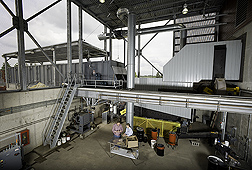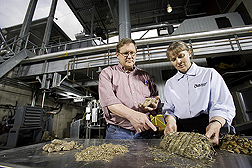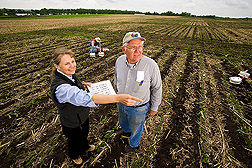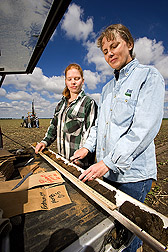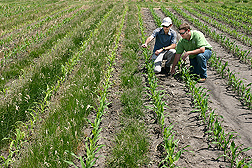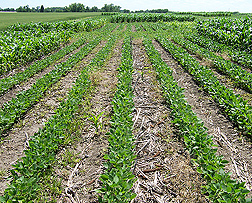In the Midwestern United States
Growing Biofuel Crops Sustainably
|
|
As crop residues are being used to produce ethanol and other biofuels, a delicate balance has to be struck between how much is removed for energy and how much is left on the ground to protect soil from erosion, maintain soil organisms, and store carbon in the soil.
The Agricultural Research Service has scientists in 18 states who are searching for that balance as a main goal of the Renewable Energy Assessment Project (REAP).
Collaborators include universities participating in the Sun Grant Initiative, which is funded through the U.S. Departments of Transportation, Energy, and Agriculture.
Because corn is currently the most widely used biofuel crop, the REAP team is especially interested in determining where, when, and how much corn stover can be harvested without harming soil productivity. “Corn stover” refers to the parts of the plant that remain after grain harvest—the leaves, stalks, and corncobs.
Dave Archer, an ARS agricultural scientist at Mandan, North Dakota, has drawn a 10-mile-radius circle around the University of Minnesota’s Morris campus for an intense study that could serve as a national model for answering questions about the use of plant residue for fuel.
Corncob Heat
The Morris campus plans to heat its buildings with gas released by a controlled burning of corn stover in a process known as “gasification.” Archer found that farmers inside the 10-mile circle can produce enough corncobs or other stover to supply the university’s gasification plant once it begins operating. And they can do so sustainably—paying attention to long-term profitability and environmental quality.
Archer says, “We’re using this gasification plant’s corn stover needs as a stand-in for the much larger needs of commercial ethanol plants, such as one that is near Morris, but outside the 10-mile circle. That plant is beginning to gasify corncobs and other biomass to replace some of the natural gas used in producing ethanol.”
To prepare for these new bioenergy uses for corn and to establish procedures for making similar cost-benefit calculations for corn bioenergy operations around the country, Archer used the ARS Environmental Policy Integrated Climate (EPIC) model to study the economics and environmental soundness of farmers’ supplying the university with corncobs or other corn stover.
“The university’s plant needs about 10,000 tons of biomass a year,” Archer says. “The circle area produces an average of 22,595 tons of corncobs a year.”
Archer used the EPIC results to compute the costs of harvesting the corncobs or corn stover, transporting the materials on the farm, and replacing soil nutrients lost from the plant biomass removal, while considering short-term effects on crop yields and soil erosion.
Economics and Corn Stover Fuel
“Ethanol plant operators use a rule of thumb that says that it’s only worth producing ethanol from corn stover if they can buy it for no more than $50 a ton,” Archer says. “If corncob harvest added only $5 per acre to corn-harvest costs, the EPIC model simulations showed that area farms could sell the corncobs profitably for anywhere from $17.95 to $33.71 a ton.”
The EPIC model showed that harvesting 40 percent of the corn stover would raise erosion rates on most soils by 0.25 tons an acre per year. Crop residues left on the soil after grain harvest tend to slow down precipitation runoff and protect soil from water erosion.
The more soil erodes, the more phosphorus washes away with it. The EPIC model showed that soil erosion and phosphorus losses could be reduced by harvesting stover from areas less susceptible to erosion, removing stover at lower rates, and choosing tillage and cropping practices with soil conservation in mind.
Soil Conservation and Corn Stover Removal
No-till or other forms of conservation tillage leave more crop residue on the soil surface by eliminating plowing. Cropping practices include long-term diverse rotations and cover crops. Archer’s colleague, Don Reicosky, then an ARS soil scientist at Morris but now retired, says that “without these changes nationally, crop residue removal could cause soil carbon levels to begin another nosedive similar to when prairie sod was busted open and intensive agriculture began, around 1870.”
Reicosky has done studies that document this, showing that rotations with diverse kinds of crops slow down the rate of carbon loss over the years. He has found that intensive tillage releases carbon dioxide from soils, so using conservation tillage can significantly reduce losses of soil carbon to the atmosphere.
In the EPIC simulations, Archer used data from studies conducted by Reicosky and Jane Johnson, also a soil scientist at Morris. Johnson is measuring corn stover and corncob yields under various levels of tillage and the amount of corn stover needed to protect soil and maintain soil carbon levels. Johnson says, “In general, conservation tillage reduces the amount of residue needed to maintain soil carbon levels. But more plant residue is needed to maintain soil carbon than to control soil erosion.”
|
|
The Morris scientists are researching whether the coproducts of gasification and pyrolysis can be used as a soil amendment to replace lost carbon and nutrients and help maintain soil quality. If so, this may further increase the amount of corn stover that could be harvested for biofuel.
Archer says that when Johnson finishes her study of minimal residue requirements to maintain soil carbon levels, he will use that information to update his EPIC analysis. He also says there is need for other research. For example, more information is needed on the cost of the cob harvest, and his study did not include costs of transporting cobs to the university’s gasification plant.
Still, removal of some residue for bioenergy may also remove a barrier to the adoption of no-till in the northern Midwest states: the concern that leaving too much residue slows the soil’s spring warm-up and drying, thus delaying planting time.
Cover Crops May Offset Carbon Losses
Using perennial groundcover roots and shoots as alternative sources of organic material is another potential way to add enough carbon to the soil to offset the carbon lost when stover is removed.
At the ARS National Soil Tilth Laboratory in Ames, Iowa, agronomist Jeremy Singer wants to identify perennial cover crops for this purpose.
Singer’s research is part of a study of optimizing corn management for biofuel production. He’s evaluating perennial grasses and a legume to assess their potential as groundcovers to mitigate soil erosion and enhance soil organic matter, even in fields where all the corn grain and stover are harvested for biofuel production. This research is partially funded by the U.S. Department of Energy through its Sun Grant Regional Partnership.
The project, which Singer is conducting with colleagues from Iowa State University at Ames, has three goals: to determine the relative competitiveness of groundcover species growing with corn; to identify whether a genetic component exists that enhances corn’s ability to compete with perennial groundcovers; and to develop management systems that minimize competition between corn and the groundcover while maximizing soil carbon contributions, soil erosion protection, and nutrient cycling.
Singer will be overseeing the component on developing management systems. “A perennial cover crop extends the function of a winter cover crop through the whole season,” Singer notes. “Besides adding soil carbon to maintain critical soil functions, it also enhances water infiltration, holds nitrogen in the soil, helps to suppress weeds, and reduces water runoff.”
Two Likely Candidates
The first season of the study was disrupted by spring floods and summer hail. But even after these challenges, the harvest results indicated that white clover and Kentucky bluegrass were likely cover crop candidates that warranted additional study. One of the grasses studied, creeping red fescue, added notable amounts of carbon to the system, but its vigorous growth hindered growth of the corn crop.
Singer and his colleagues now need to see whether their initial findings will hold up with further research. Then they need to combine their findings with other research on corn hybrids that can share their space with perennial cover crops and still provide good yields.
When the best groundcover has been identified, using no-till and other reduced-tillage practices in the corn-groundcover system will reduce the amount of fossil fuel needed to prepare and plant the crops. This, in turn, will likely decrease greenhouse gas emissions—another prospective plus for farmers and fields alike.—By Don Comis and Ann Perry, Agricultural Research Service Information Staff.
This research is part of Bioenergy and Energy Alternatives (#307) and Agricultural System Competitiveness and Sustainability (#216), two ARS national programs described on the World Wide Web at www.nps.ars.usda.gov.
David W. Archer is in the USDA-ARS Northern Great Plains Research Laboratory, 1701 10th Ave. S.W., Room 104, P.O. Box 459, Mandan, ND 58554; phone (701) 667-3048, fax (701) 667-3054.
Jane M.F. Johnson is with the USDA-ARS North Central Soil Conservation Research Laboratory, 803 Iowa Ave., Morris, MN 56267; phone (320) 589-3411, ext. 131, fax (320) 589-3787.
Jeremy Singer is with the USDA-ARS Agricultural Land and Watershed Management Research Unit, 2110 University Blvd., Ames, IA 50011; phone (515) 294-5502, fax (515) 294-8125.
"In the Midwestern United States: Growing Biofuel Crops Sustainably" was published in the September 2009 issue of Agricultural Research magazine.







